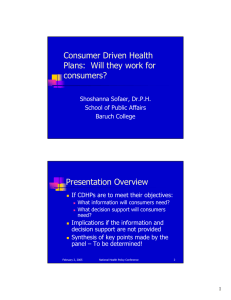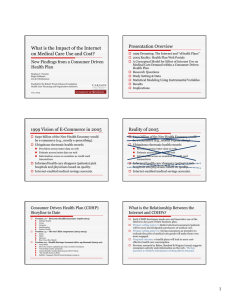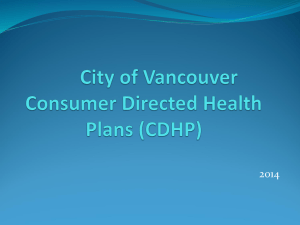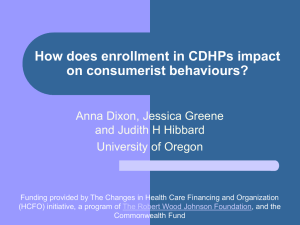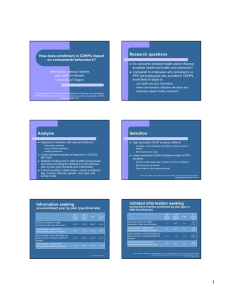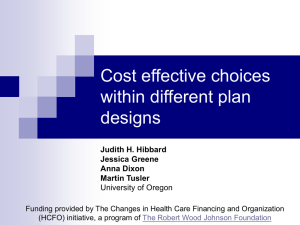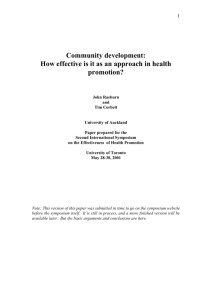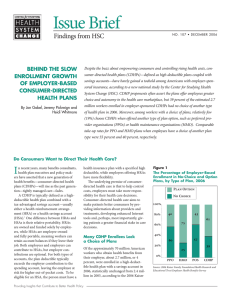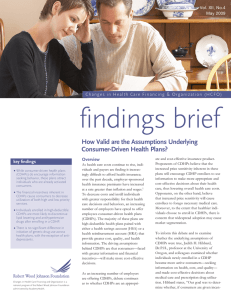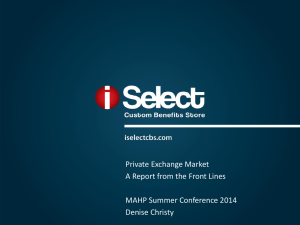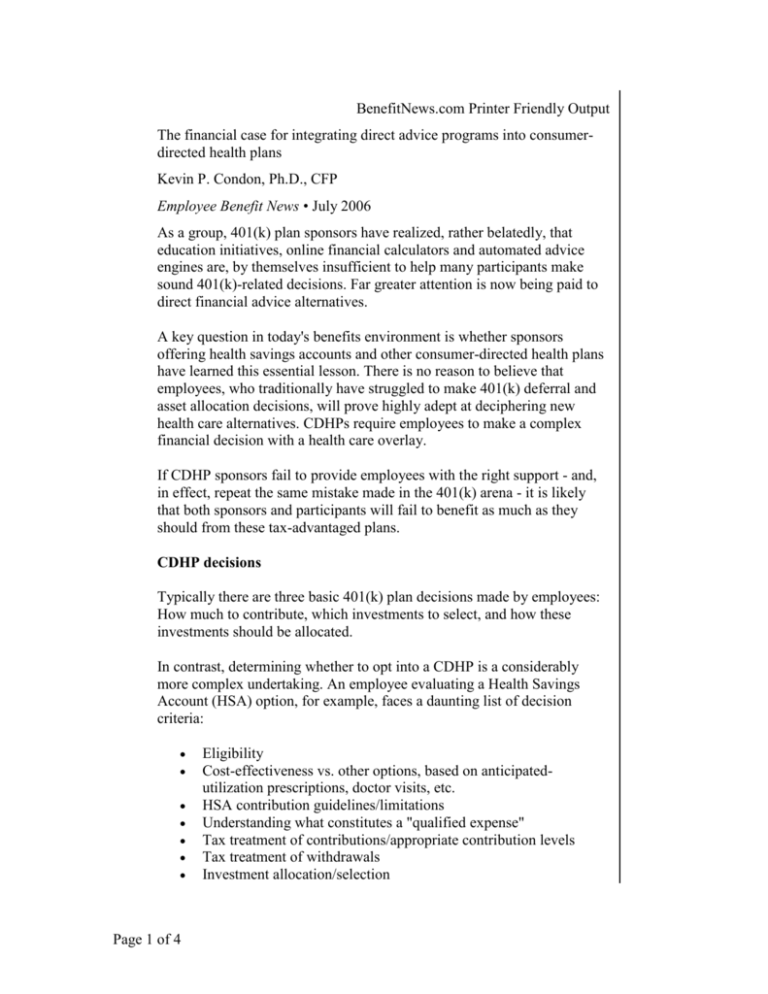
BenefitNews.com Printer Friendly Output
The financial case for integrating direct advice programs into consumerdirected health plans
Kevin P. Condon, Ph.D., CFP
Employee Benefit News • July 2006
As a group, 401(k) plan sponsors have realized, rather belatedly, that
education initiatives, online financial calculators and automated advice
engines are, by themselves insufficient to help many participants make
sound 401(k)-related decisions. Far greater attention is now being paid to
direct financial advice alternatives.
A key question in today's benefits environment is whether sponsors
offering health savings accounts and other consumer-directed health plans
have learned this essential lesson. There is no reason to believe that
employees, who traditionally have struggled to make 401(k) deferral and
asset allocation decisions, will prove highly adept at deciphering new
health care alternatives. CDHPs require employees to make a complex
financial decision with a health care overlay.
If CDHP sponsors fail to provide employees with the right support - and,
in effect, repeat the same mistake made in the 401(k) arena - it is likely
that both sponsors and participants will fail to benefit as much as they
should from these tax-advantaged plans.
CDHP decisions
Typically there are three basic 401(k) plan decisions made by employees:
How much to contribute, which investments to select, and how these
investments should be allocated.
In contrast, determining whether to opt into a CDHP is a considerably
more complex undertaking. An employee evaluating a Health Savings
Account (HSA) option, for example, faces a daunting list of decision
criteria:
Page 1 of 4
Eligibility
Cost-effectiveness vs. other options, based on anticipatedutilization prescriptions, doctor visits, etc.
HSA contribution guidelines/limitations
Understanding what constitutes a "qualified expense"
Tax treatment of contributions/appropriate contribution levels
Tax treatment of withdrawals
Investment allocation/selection
Other important features with which the employee is unfamiliar:
portability, use as a savings vehicle, ability to pay LTC premiums,
etc.
Based on past experience related to participant decision-making behavior
in defined contribution retirement plans, we can safely assume that the
average employee is ill-equipped to effectively process all of these
decision criteria. Whether to participate and how much to contribute are
sources of confusion that can lead to inaction - and that can be detrimental
both to employers and their employees.
Low participation rate
Indeed, we believe that the complexity associated with CDHP decisions is
a major reason for the current low participation rates. According to a
recent survey by Mercer Health & Benefits, "A scant 1% of all covered
employees were enrolled in [a CDHP] in 2005." A Fidelity Investments
survey, which focused solely on large companies, estimated enrollment to
be less than 4%.
One-third of the HR managers who responded to OnlineBenefits'
consumer-driven healthcare survey of U.S. businesses expect CDH to
"cause confusion for employees." The survey also found that respondents
believe that communications (86%) and financial planning (74%) are
important factors to the success of CDHP plans. This is echoed by the
Mercer study, in which about two-thirds of large employers said
employees require more assistance in making the decision to enroll in a
CDHP.
Integrating third-party advice
If the 401(k) experience holds true for CDHPs, we can reasonably assume
that without a direct advice program, numerous participants will take no
action - or will make decisions that do not serve their best interests. A
template for integrating third-party advice into a CDHP environment
would most likely conform to these specifications:
Page 2 of 4
Scalable. The advice program must be available to employee
populations that can run from hundreds to thousands of potential
participants, and who may be dispersed across a wide range of
company locations.
Easy access. Experience dictates that workplace advice programs
work best when employees can access them from anywhere and at
times they find convenient. Employees view limited access as an
obstacle.
Personal dialogue. Employees are more prone to seek advice
when they can communicate directly with an advisor and when the
advisor is prepared to discuss the participant's specific situation,
goals and questions. The 401(k) experience has repeatedly
demonstrated that advice programs fail to gain traction when they
involve data entry into intimidating software applications and little
opportunity for dialogue with a trusted advisor.
Impartial advice. It is essential for both employers and employees
to perceive that the advice offered is totally impartial and free from
any financial incentives that could compromise an advisor's
recommendations.
Qualified advisors. CDHP guidance requires financial advisors
who are knowledgeable about taxes, investments, insurance,
financial planning and cash flow issues. Ideally, all advisors should
be licensed and have appropriate credentials.
Employer-paid. The 401(k) experience strongly suggests that
large numbers of plan participants will not take advantage of
employee-paid advice programs.
Economic incentive for employer. Companies will be hesitant to
invest in CDHP advice programs unless they can be shown to
provide a financial return (see chart).
Program results
The following example provides a clear illustration of how even a modest
boost in CDHP participation can dramatically reduce an employer's health
care costs.
In our example, we assume that Company ABC has 5,000 employees and
can save:
7.65% of FICA for every dollar contributed to tax-advantaged
accounts
an average of 20% to 25% in reduced premium or claims costs if
employees shift to more cost-effective plans such as highdeductible health plans.
ABC Company introduced an HSA into its benefit plan more than a year
ago, and relied heavily on a CDHP information portal and group
educational seminars. Despite these efforts, employee participation has
remained slightly below 2%, which is in keeping with industry averages.
The company is willing to test whether one-to-one advice for employees
has the potential to improve employee decision-making and thereby
increase CDHP participation rates.
The company contracts with an external provider that can deliver impartial
financial advice on a scalable basis at a cost of $37,500 or $7.50 per
Page 3 of 4
employee, based on the utilization shown in the chart above.
As the chart illustrates, a 5% increase in CDHP participation may enable
the company to enjoy an annual savings of nearly $142,205. This includes
the $37,500 outlay for external advice. It is worth noting that the company,
in this example, does not have to meet this 5% target to cover its advice
costs. Even with a modest 2.5% increase, the firm still comes out ahead
financially - and provides a key benefit to employees. On the other hand, if
participation rates increased by 10%, the return on investment for the
employer would be $244,000 in Year 1 alone.
There is a strong financial incentive for sponsors of HSAs and other
CDHPs to not repeat the 401(k) experience, which clearly has shown that
traditional education programs, interactive information portals, automated
advice engines and calculators are not effective in helping many
employees make difficult decisions. There also is a strong financial
incentive for employers to boost CDHP participation rates, and direct
financial advice programs may be the best potential solution to help
employers achieve this goal.
Kevin P. Condon, Ph.D., CFP, is executive vice president of
myfinancialadvice.com. - E.B.N.
Copyright © 2001 IMG Media, a division of Thomson Financial. All
rights reserved.
Page 4 of 4

